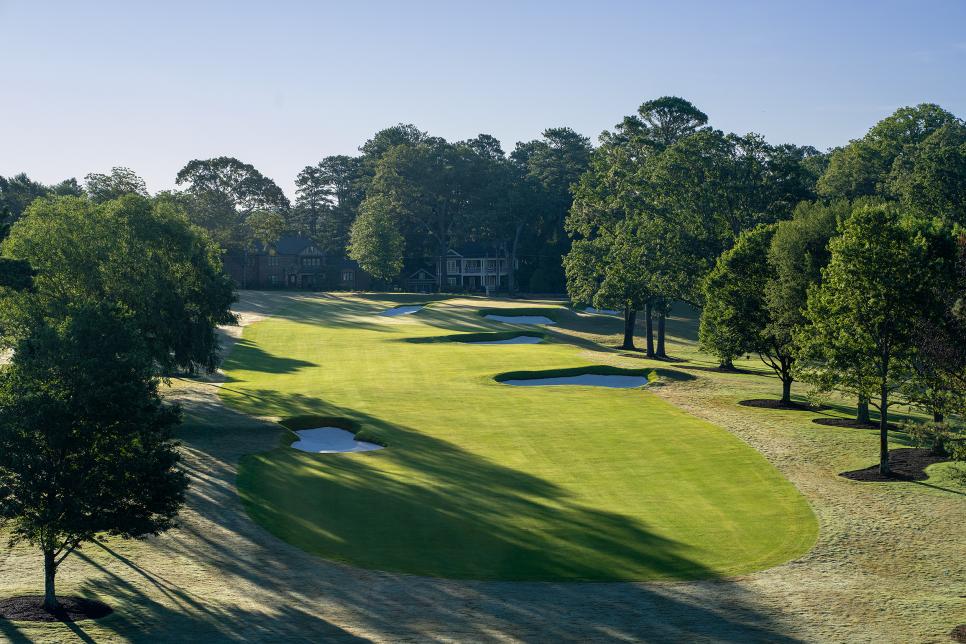Why the Tour Championship is going to look drastically different this year at East Lake – Australian Golf Digest

- by Admin
- August 15, 2024

When the Tour Championship returns to its familiar host venue, East Lake Golf Club in Atlanta, it will look anything but familiar.
The club has just completed the most extensive restoration of the course since Rees Jones redesigned it in the mid-1990s when the PGA Tour was negotiating with the club to become a regular host of the event (East Lake has been the site of the Tour Championship continuously since 2004).
This time around the architect is Andrew Green, whose recent reinventions of Inverness Club (in 2018), Congressional’s Blue Course (2020) and Scioto Country Club (2022) have helped elevate those clubs in the America’s 100 Greatest Courses rankings. He also orchestrated a major remodel of Oak Hill’s East Course, host of the 2023 PGA Championship, in 2019.
Courtesy of the club Private East Lake Golf Club Atlanta, GA, United States 3.9 167 Panelists
- Second 100 Greatest
- Best In State
Tom Bendelow actually laid out the original course at East Lake, back when it was known as Atlanta Athletic Club, and that was the layout upon which Stewart Maiden taught the game to the now-legendary Bobby Jones. Donald Ross basically built a new course on the same spot in 1915, which remained untouched until changes were made before the 1963 Ryder Cup. Rees Jones redesigned most holes beginning in the mid-90s, making the course more reflective of his views of championship golf. East Lake will undergo another major renovation following the 2023 Tour Championship, this time by Andrew Green, who will highlight the Donald Ross heritage.
Explore our course review TURNING BACK THE CLOCK 
East Lake’s uphill par-4 fourth.
Green’s work at East Lake, which wrapped up in the late spring, is being called a restoration, but to viewers, it will appear as a transformation. No holes were rerouted (although numerous greens were shifted)—but little else remains the same.
While East Lake is a historic property—Bobby Jones grew up playing the course, and Donald Ross conducted its first major remodel in 1915—the golf course felt and played more modern than vintage and bore only a glancing resemblance to the course Jones and Ross knew. The concept of the renovation was to take the course back to an earlier version, one that better embodied the design Ross left behind at East Lake.
Green used an aerial from 1949, over a decade before architect George Cobb’s revised the course for the 1963 Ryder Cup, to guide the restoration. The photo shows Ross’ bunkering at a smaller scale than what was developed by Cobb, and later, Jones—a style Green interpreted as being deep-welled with steep grass faces based on his knowledge of other Ross courses. The bunkers, repositioned as much as possible to where Ross had located them, have a sharper top edge that give them enhanced definition, and they can cause issues when balls settle too close to the face.
READING THE GREENS 
Icon Sportswire
In the years after World War II, East Lake, like many clubs in the southeast, began maintaining two green surfaces on each hole, one with cool season bentgrass that could be played over the winter months, and another with Bermudagrass that goes dormant when it’s cold but thrives in the heat.
Sometimes the two putting surfaces were set side by side, and on other holes, the Bermuda green might be placed in the front section of the green pad and the bent at the rear, or vice versa. Green used these old arrangements to inspire his redesign of the green complexes, using the old double-green outlines to inform the shapes of the new greens, now planted with TifEagle.
The greens, which sit lower and more tightly connected to their surroundings, are also larger and feature expanded perimeter options for hole locations. The putting surface at the uphill par-3 second is over 9,000 square feet, nearly 3,000 square feet larger than previously with a sinister back left pin placement perched over a swale.
In addition to the retro-refurbished bunkers and greens, Green recontoured the fairways to create more movement and slide. In dry conditions, they’ll run faster with the switch to Zorro Zoysia. Tees have also been adjusted to emphasize more shot shaping, and the course underwent significant tree removal, which in effect draws greater attention to the lovely mature individual species that remain.
The yardage has only slightly increased to 7,455 yards, and the par is now 71 versus 70 because the downhill 14th will be played as a par 5 as it does for the members (the tour moved the tees up and played it as a par 4 during Tour Championships).
The key to scoring well at East Lake remains the same: Keep the ball out of the bristly Bermuda rough. But the shots into and around the green will offer more variety with the expanded hole locations, as well as more options for recovery with added short-grass surrounds.
One of the most fascinating changes has been to the 16th green complex. The blind green was formerly turned right to left over a bunker with mounding toward the rear. The putting surface is now narrower and much deeper, and the entire right side and right rear over the green, not visible from the fairway, has been carved away, tumbling eight feet down into a chipping area depression. Players who hunt for pins on the right side have no room to miss and many will be pitching back up from a bilnd position.
Let’s take a look at some of the other notable transformations.
More From Golf Digest  Golf Digest Logo Glory’s Cost: Will money ruin the chase for golf greatness?
Golf Digest Logo Glory’s Cost: Will money ruin the chase for golf greatness?  News & Tours PGA Tour releases 2025 schedule with no PIF deal in sight
News & Tours PGA Tour releases 2025 schedule with no PIF deal in sight  Crunching the Numbers 15 oddly fascinating statistics about the FedEx Cup Playoffs
Crunching the Numbers 15 oddly fascinating statistics about the FedEx Cup Playoffs
This article was originally published on golfdigest.com
The Latest News
-
January 10, 2025’Worst time in my life’: World No. 2 opens up on drugs ban ahead of Australian Open
-
January 10, 2025Emma Raducanu dismisses fitness concerns in optimistic Australian Open verdict
-
January 10, 2025Emma Raducanu avoids drugs test concern just days before Australian Open after flare up
-
January 10, 2025Medvedev vying to steal two titles off young guns
-
January 10, 2025Not-so-new kid on the block: ‘mature’ Litchfield set for Ashes | cricket.com.au





